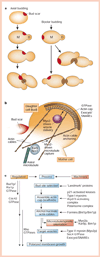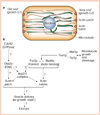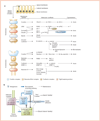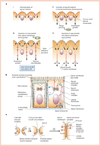Adaptation of core mechanisms to generate cell polarity
- PMID: 12700771
- PMCID: PMC3373010
- DOI: 10.1038/nature01602
Adaptation of core mechanisms to generate cell polarity
Abstract
Cell polarity is defined as asymmetry in cell shape, protein distributions and cell functions. It is characteristic of single-cell organisms, including yeast and bacteria, and cells in tissues of multi-cell organisms such as epithelia in worms, flies and mammals. This diversity raises several questions: do different cell types use different mechanisms to generate polarity, how is polarity signalled, how do cells react to that signal, and how is structural polarity translated into specialized functions? Analysis of evolutionarily diverse cell types reveals that cell-surface landmarks adapt core pathways for cytoskeleton assembly and protein transport to generate cell polarity.
Figures





Comment in
-
The cytoskeleton, cellular motility and the reductionist agenda.Nature. 2003 Apr 17;422(6933):741-5. doi: 10.1038/nature01598. Nature. 2003. PMID: 12700767
References
-
- Chant J. Cell polarity in yeast. Annu. Rev. Cell Dev. Biol. 1999;15:365–391. - PubMed
-
- Chant J, Herskowitz I. Genetic control of bud site selection in yeast by a set of gene products that constitute a morphogenetic pathway. Cell. 1991;65:1203–1212. - PubMed
-
- Pruyne D, Bretscher A. Polarization of cell growth in yeast I. Establishment and maintenance of polarity states. J. Cell Sci. 2000;113:365–375. - PubMed
Publication types
MeSH terms
Grants and funding
LinkOut - more resources
Full Text Sources
Other Literature Sources
Molecular Biology Databases

